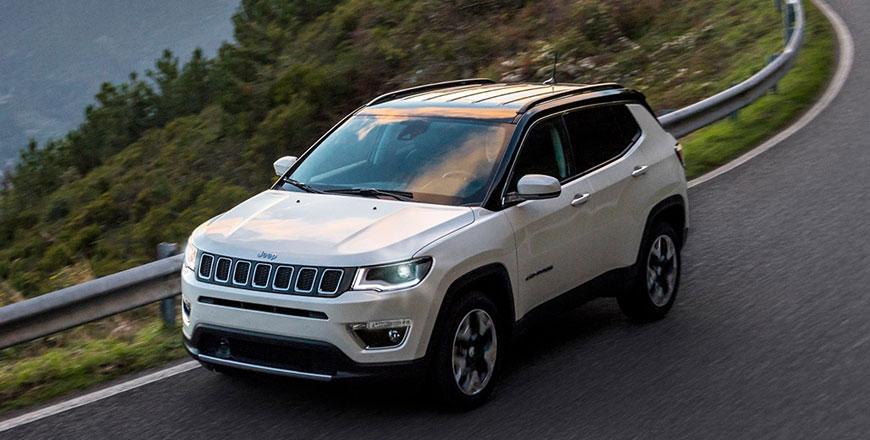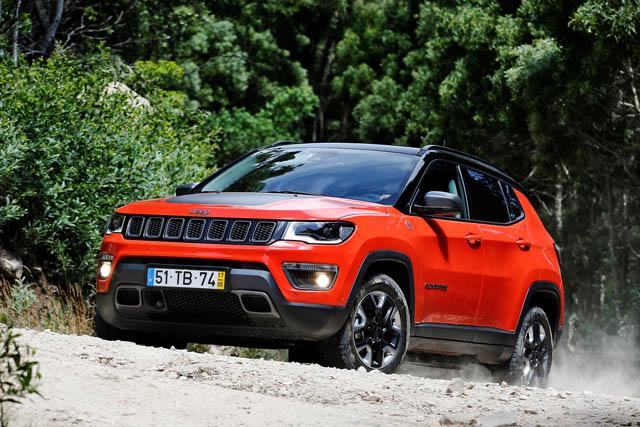You are here
Jeep Compass Limited 1.4 Multiair (4x2): Navigating the urban jungle and beyond
By Ghaith Madadha - Sep 18,2017 - Last updated at Sep 18,2017

Photo courtesy of Jeep
Fiat-Chrysler Automotive’s (FCA) latest offering into the ever more popular and competitive compact SUV segment from its consistently popular Jeep brand, the latest generation Compass is modern, well equipped, well-packaged and efficient, and draws on the brand’s rich heritage.
Available in several petrol and diesel engines, drive-lines and versions including a capably off-road focused Trailhawk range topper for more adventurous drivers, the Limited trim version is however the most refined, and mated with entry-level 1.4-litre petrol engine and front-wheel-drive, is the urban warrior of the range.
Rugged appeal
Built on the FCA group’s “wide small architecture” with a stiff structure employing 65 per cent high strength steel construction for improving driving dynamics and comfort, and collision safety, the Jeep Compass also rides on independent front and rear suspension.
Offered with a range of colours including bright and bold hues, the Compass exudes a sense of presence, and employs a design language largely derived from its considerably larger and familiar Grand Cherokee stable mate, most evident from its upright front fascia, broad rear lights and wide and muscular stance.
With a noticeably more rugged and somewhat traditional SUV design aesthetic, the Compass strikes a more visceral chord, and features a slim and high-set interpretation of Jeep’s signature seven-slot grille, with gloss black background and honeycomb mesh inlets. Its squinting and browed headlights feature lower LED strips for moody emphasis, while lower black cladding along the bumpers flanks adds to its rugged appeal.
Muscularly surfaced bodywork includes bulging squared-off wheelarches in traditional Jeep fashion, while a rakishly descending floating roof line with forward jutting body colour C-pillar create a sense of momentum.
Efficient and innovative
Powered by a transversely mounted turbocharged direct injection 1.4-litre four cylinder engine, the Compass features Fiat’s innovative and efficient Multiair technology with electro-hydraulic air intake control, which improves power and torque, and reduces consumption and emissions. Available in 167BHP state of tune in four wheel drive versions, the lighter 1505kg front wheel drive Compass featured, however, receives a more efficient lower output version of the same engine.
Developing 138BHP at 5000rpm and 169lb/ft torque by just 1400rpm, it accelerates through the 0-100km/h benchmark in 9.9-seconds and onto a 192km/h top speed.
Mated to a six-speed manual gearbox in front-drive guise — rather than a nine-speed automatic available on other models — and with a stop/start system, the Compass 1.4 Multiair returns low 6.2l/100km fuel consumption and 143g/km CO2 emissions, combined.
Relatively low-revving and refined in character, the Compass 1.4’ under square designed engine is at its best throughout a broad mid-range where maximum torque is available and power is building up, rather than below 1400rpm or at top-end beyond 5000rpm. Meanwhile, front ventilated and solid rear disc brakes are confident and reassuring.
Refined and manoeuvrable
Refined, versatile and confidently stable on highway and for an entry-level engine, one however needs to work the Compass 1.4’s gearbox more often to get the best out of it, which with quick and light shifter and light intuitive clutch pick-up, makes it more fun to drive than an auto.
Manoeuvrable and easy to drive, the Compass offers good visibility and is easier to place in tight confines — whether in town or off-road — than its comparatively broad bonnet and width might suggest. Steering is light with a tight turning circle.
Driven through Sintra national park’s narrow and winding hill climbs in Portugal during its global launch earlier this year, the Compass proved Nimble and agile as SUVs go. Steering was quick and accurate if not especially nuanced in road feel, while independent suspension with frequency adaptive damping provided a refined, comfortable and fluent ride over imperfections and decent, if not overly firm and sporty body lean control through corners. Driven with 17-inch alloy wheels and taller sidewall 225/60R17 tyres, the Compass was also supple over lumps and bumps.
Comfort and convenience
Settled over crests and dips, the compass felt reassuring and controlled, while driving position is alert and well adjustable, with big comfortable seats and chunky multi-function steering wheel. Primarily intended for road use in front-drive guise and Limited trim, the driven compass may not have the same electronic software or 4x4 hardware as other Compass versions.
It nonetheless offers more off-road capability than most drivers will need, including 198mm ground clearance, 406mm water fording, and 15.8° approach, 21.8° break-over and 30.8° departure angles.
User-friendly, easily accessible and accommodating for larger passengers inside, the Compass features good in-segment materials and soft textures inside, while layouts are intuitive and design pleasant. Spacious for passengers in front and rear, and with generous 438-litre minimum and 1251-litre maximum cargo capacity, the Compass is well packaged.
Standard and optional equipment levels are high and feature driver assistance and safety system including lane departure, and collision warnings, parking assistance, blindspot and rear crosspath detection and adaptive cruise control, while extensive convenience features include power tailgate and 8.4-inch Uconnect infotainment system, as tested.
TECHNICAL SPECIFICATIONS
Engine: 1.4-litre, transverse, turbocharged 4-cylinders
Bore x Stroke: 72 x 84mm
Compression ratio: 10:1
Valve-train: 16-valve, direct injection, variable timing
Gearbox: 6-speed manual, front-wheel-drive
Gear ratios: 1st 4.154:1; 2nd 2.118:1; 3rd 1.361:1; 4th 0.978:1; 5th 0.756:1; 6th 0.622:1
Reverse/final drive: 4:1/4.438:1
Power, BHP (PS) [kW]: 138 (140) [103] @5000rpm
Specific power: 100.8BHP/litre
Power-to-weight: 91.7BHP/tonne
Torque, lb/ft (Nm): 169.6 (230) @1750rpm
Specific torque: 168.1Nm/litre
Torque-to-weight: 152.8Nm/tonne
0-100km/h: 9.9-seconds
Top speed: 192km/h
Fuel consumption, urban/extra-urban/combined; 7.8-/5.2-/6.2-litres/100km
CO2 emissions, combined: 143g/km
Length: 4394mm
Width: 1819mm
Height: 1624mm
Wheelbase: 2636mm
Track: 1547mm
Ground clearance: 198mm
Approach/break-over/departure angles: 15.8°/21.8°/30.8°
Water fording: 406mm
Seating: 5
Headroom, F/R: 995/978mm
Legroom, F/R: 1046/973mm
Shoulder room, F/R: 1439/1400mm
Trunk height, length, width: 691, 605, 1069mm
Cargo volume min/max, with tire repair kit: 438-/1251-litres
Fuel capacity: 60-liters
Unladen weight: 1505kg
Trailer towing maximum: 1000kg
Steering: Electric-assisted rack & pinion
Steering ratio: 16.5:1
Lock-to-lock: 2.68-turns
Turning circle: 11.07-metres
Suspension, F/R: MacPherson struts/Chapman struts
Brakes, F/R: Ventilated discs/discs
Tyres: 225/60R17
Related Articles
That from afar and to the untrained eye, the new Jeep Compass seems uncannily similar to the iconic off-road brand’s largest Grand Cherokee
The range-topping and off-road oriented version of what is already one of the best off-road vehicles money can buy, the Jeep Wrangler Rubico
Introduced for the 2020 model year, the Jeep Gladiator marks the iconic American brand’s long-awaited return to the pick-up market since the

















